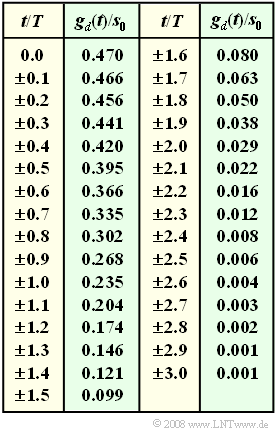Exercise 3.8Z: Optimal Detection Time for DFE
As in "Exercise 3.8", we consider the bipolar binary system with decision feedback equalization (DFE).
The pre-equalized basic pulse gd(t) at the input of the DFE corresponds to the rectangular response of a Gaussian low-pass filter with the cutoff frequency fG⋅T=0.25.
In the ideal DFE, a compensation pulse gw(t) is formed which is exactly equal to the input pulse gd(t) for all times t≥TD+TV, so that the following applies to the corrected basic pulse:
- gk(t) = gd(t)−gw(t)= {gd(t)0forfort<TD+TV,t≥TD+TV,
Here TD denotes the detection time, which is a system variable that can be optimized. TD=0 denotes symbol detection at the pulse midpoint.
- However, for a system with DFE, gk(t) is strongly asymmetric, so a detection time TD<0 is more favorable.
- The delay time TV=T/2 indicates that the DFE does not take effect until half a symbol duration after detection.
- However, TV is not relevant for solving this exercise.
A low-effort realization of the DFE is possible with a delay filter, where the filter order must be at least N=3 for the given basic pulse. The filter coefficients are to be selected as follows:
- k1=gd(TD+T),k2=gd(TD+2T),k3=gd(TD+3T).
Notes:
- The exercise belongs to the chapter "Decision Feedback".
- Note also that decision feedback is not associated with an increase in noise power, so that an increase in (half) eye opening by a factor of K simultaneously results in a signal-to-noise ratio gain of 20⋅lgK.
- The pre-equalized basic pulse gd(t) at the DFE input corresponds to the rectangular response of a Gaussian low-pass filter with the cutoff frequency fG=0.25/T.
- The table shows the sample values of gd(t) normalized to s0. The information section for "Exercise 3.8" shows a sketch of gd(t).
Questions
Solution
- ¨o(TD)2=gd(0)−gd(−T)−gd(−2T)−gd(−3T)
- ⇒¨o(TD)2⋅s0=0.470−0.235−0.029−0.001=0.205_.
(2) The coefficients should be chosen such that gk(t) fully compensates for the trailer of gd(t):
- k1=gd(T)=0.235_,k2=gd(2T)=0.029_,k3=gd(3T)=0.001_.
(3) Based on the result of subtask (1), we obtain:
- ¨o(TD)2⋅s0=0.205−0.5⋅(0.235+0.029+0.001)=0.072_.
(4) Optimizing TD according to the entries in the table yields:
- TD/T=0:¨o(TD)/(2s0)=0.470–0.235–0.029–0.001=0.205,
- TD/T= –0.1:¨o(TD)/(2s0)=0.466 – 0.204 – 0.022 – 0.001=0.240,
- TD/T= –0.2:¨o(TD)/(2s0)=0.456 – 0.174 – 0.016 – 0.001=0.266,
- TD/T= –0.3:¨o(TD)/(2s0)=0.441 – 0.146 – 0.012 – 0.001=0.283,
- TD/T= –0.4:¨o(TD)/(2s0)=0.420 – 0.121 – 0.008 – 0.001=0.291,
- TD/T= –0.5:¨o(TD)/(2s0)=0.395 – 0.099 – 0.006 – 0.001=0.290,
- TD/T= –0.6:¨o(TD)/(2s0)=0.366 – 0.080 – 0.004 – 0.001=0.282,
- Thus, the optimal detection time is TD, opt = –0.4T_ (probably slightly larger).
- For this, the maximum value (0.291_) was determined for the half eye opening.
(5) With TD= –0.4 T, the filter coefficients are:
- k1=gd(0.6T)=0.366_,k2=gd(1.6T)=0.080_,k3=gd(2.6T)=0.004_.
(6) Using the same procedure as in subtask (3), we obtain here:
- ¨o(TD,opt)2⋅s0=0.291−0.5⋅(0.366+0.080+0.004)=0.066_.
The results of this exercise can be summarized as follows:
- Optimizing the detection timing ideally increases the eye opening by a factor of 0.291/0.205=1.42, which corresponds to the signal-to-noise ratio gain of 20⋅lg1.42≈3 dB.
- However, if the DFE functions only 50% due to realization inaccuracies, then with TD= –0.4T there is a degradation by the amplitude factor 0.291/0.066≈4.4 compared to the ideal DFE. For TD=0, this factor is much smaller with 2.05/0.072≈3.
- In fact, the actually worse system (with TD=0) is superior to the actually better system (with TD= –0.4T), if the decision feedback works only 50%. Then there is a SNR loss of 20⋅lg(0.072/0.066)≈0.75 dB.
- One can generalize these statements: The larger the improvement by system optimization (here: the optimization of the detection time) is in the ideal case, the larger is also the degradation at non-ideal conditions, e.g., at tolerance-bounded realization.
